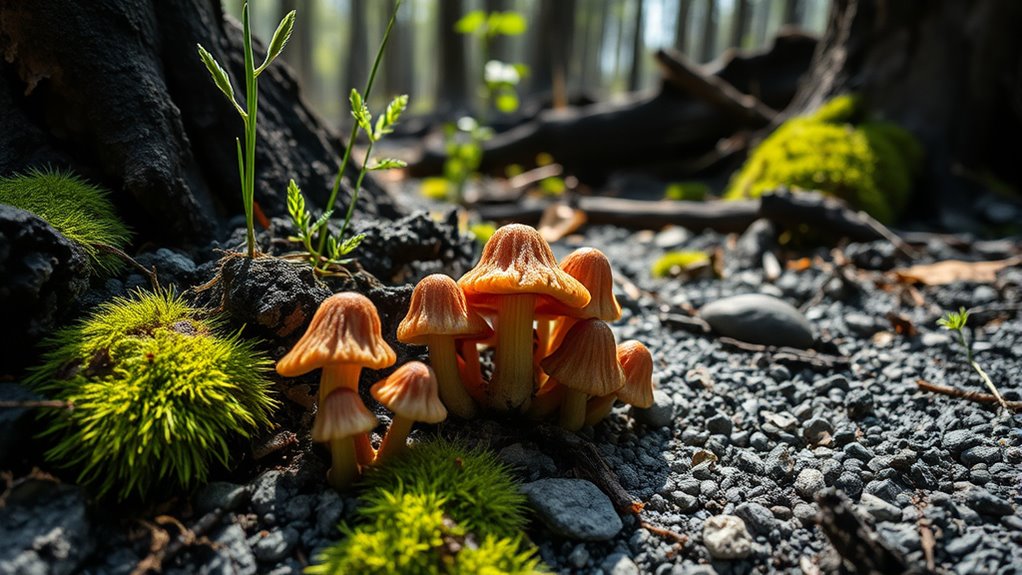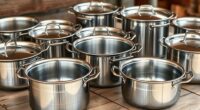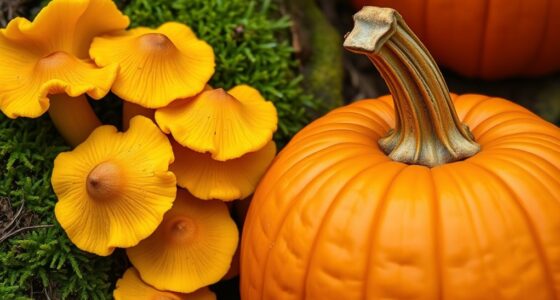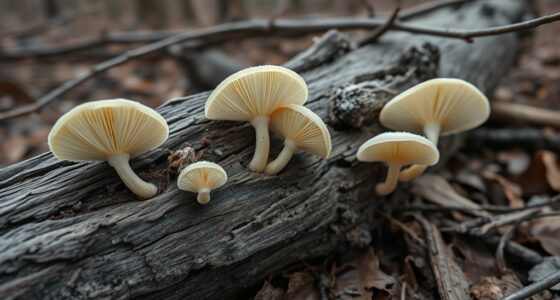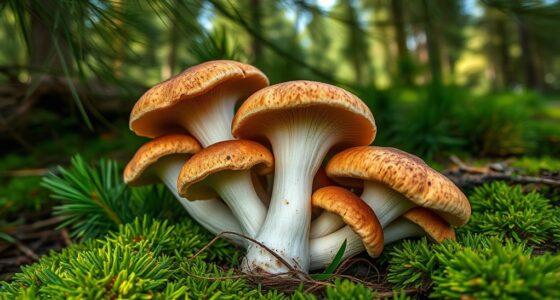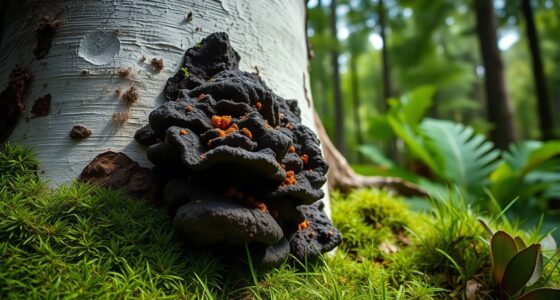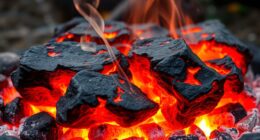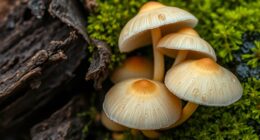After a wildfire, you can find morels thriving in the nutrient-rich, cleared soil areas. Wait a few weeks for the fire’s effects to boost mushroom growth, typically in spring or early summer. Look for authentic morels by their conical caps with a honeycomb surface and hollow stems, avoiding lookalikes. Use proper tools, follow local regulations, and harvest responsibly to safeguard the ecosystem. Discover more tips to ensure a safe, sustainable foraging experience.
Key Takeaways
- Look for morels emerging within weeks after a fire, typically in spring or early summer, in areas with recent burn activity.
- Identify authentic morels by their conical caps with honeycomb textures and hollow stems, avoiding lookalikes.
- Use proper tools, carry permits if required, and harvest sustainably to support ecosystem recovery.
- Assess soil moisture and temperature, and monitor environmental conditions to optimize foraging timing.
- Prioritize safety by inspecting terrain, avoiding hazards, and properly cleaning and storing harvested mushrooms.
Understanding the Impact of Wildfires on Morel Growth
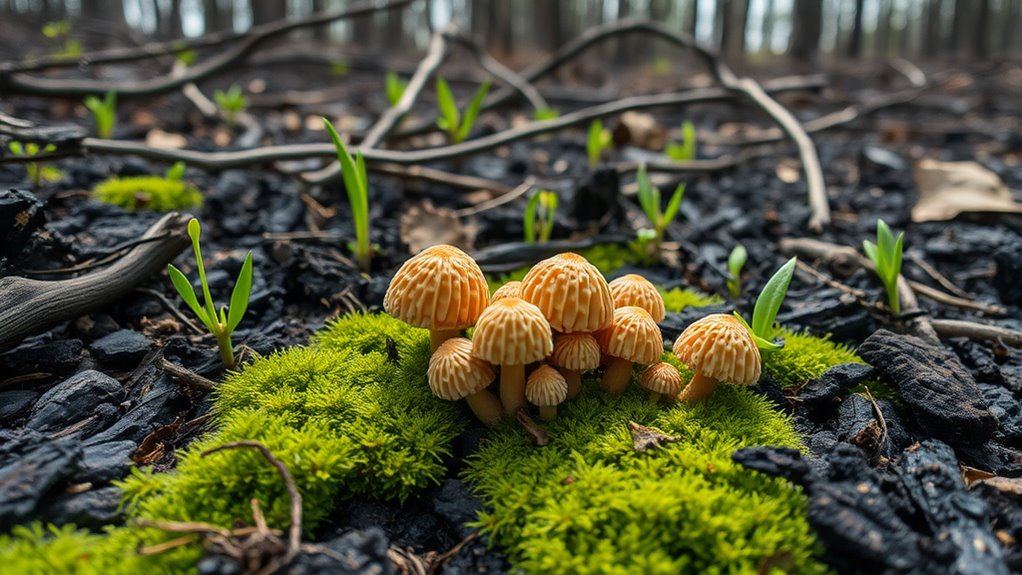
Wildfires substantially influence morel mushroom growth, often creating conditions that can either promote or hinder their development. After a fire, soil recovery plays a pivotal role, as nutrients are released and the soil becomes more fertile, encouraging morel proliferation. Fire ecology helps explain these dynamics, highlighting how ecosystems adapt and rebound following burn events. The removal of dense vegetation allows morels to access sunlight and grow more freely. Additionally, the ash from fires enriches the soil with minerals, creating an ideal environment for spores to establish. However, if fires are too intense or frequent, they can damage underground mycelium, hindering future growth. Understanding these ecological processes helps you anticipate where and when morels are likely to flourish post-wildfire. Moreover, the timing of post-fire growth is influenced by soil recovery, which depends on factors like soil temperature, moisture levels, and microbial activity.
The Optimal Timing for Post-Wildfire Foraging

You’ll find that the best time to forage for morels after a wildfire depends on environmental conditions. As temperatures rise and moisture levels fluctuate, mushrooms tend to appear more reliably. Keeping an eye on these factors helps you target the right window for a successful hunt.
When Mushrooms Appear
After a wildfire clears out the dense undergrowth, morels often make their first appearance within a few weeks, depending on local conditions. This timing aligns with fire ecology principles, as the disturbance triggers the growth of many fungi, including morels. Typically, you’ll find them emerging in spring or early summer when soil temperatures rise. Keep an eye on burn sites, especially where the fire was recent and vegetation is still sparse. For those interested in mushroom cultivation, understanding when wild morels appear can inform controlled experiments. Additionally, monitoring soil conditions can help identify optimal foraging periods, as fungi respond sensitively to changes in soil nutrients and moisture.
Environmental Conditions Influence
Environmental conditions such as soil temperature, moisture levels, and recent weather patterns play a crucial role in determining the ideal timing for foraging morels after a wildfire. Healthy soil nutrients and adequate moisture levels create favorable conditions for morel growth. After a fire, the soil often becomes nutrient-rich, but if moisture levels are too low, mushrooms may not appear promptly. Conversely, excessive moisture from recent rain can delay fruiting or cause rot. Pay attention to soil temperature, which should warm gradually to stimulate mycelium development without causing stress. Monitoring these factors helps you identify the best window for foraging. By understanding how soil nutrients and moisture levels influence morel emergence, you can increase your chances of a successful harvest post-wildfire. Additionally, soil temperature plays a significant role in promoting healthy mushroom development, making it essential to track these changes over time.
Identifying Authentic Morels in Burned Areas
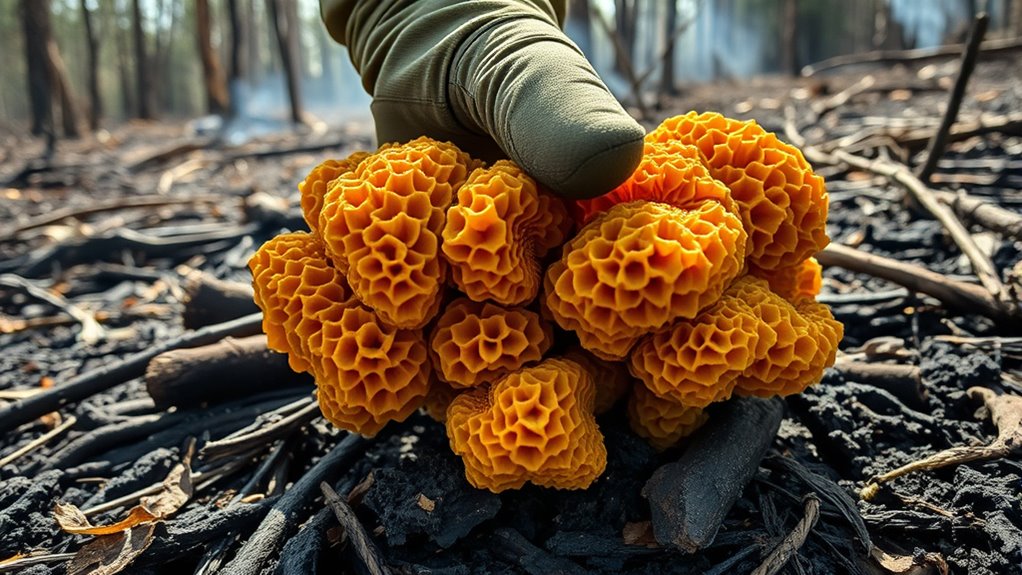
When searching for authentic morels, focus on their distinctive cap and stem shapes. Watch out for common lookalikes that mimic their appearance but lack the true morel’s texture and structure. Recognizing these key features helps confirm you harvest safe, genuine morels in burned areas. Additionally, understanding best anime movies can provide insight into the cultural significance of natural imagery and storytelling.
Recognizing Authentic Shapes
Authentic morels have distinct shapes that set them apart from false varieties, especially in burned areas. Their mushroom morphology features a conical or cylindrical cap with a honeycomb-like surface, tapering into a slender stem. Recognizing these authentic shapes is vital for foraging safety. True morels lack the bulbous or irregular features common in false ones. Use this imagery to guide your search:
| Authentic Morel | False Lookalike |
|---|---|
| Conical or cylindrical cap | Rounded or irregular cap |
| Honeycomb surface | Pitted or bumpy surface |
| Thin, elongated stem | Thick or bulbous stem |
| Uniform shape | Misshapen or uneven |
| Smooth, consistent texture | Rough or uneven texture |
Mastering mushroom morphology helps you identify genuine morels and avoid dangerous lookalikes. Additionally, understanding the mushroom habitat can improve your foraging success and safety.
Spotting Common Lookalikes
Identifying genuine morels in burned areas requires careful attention to their lookalikes, which often thrive in similar conditions. Seasonal variations can make it tricky, as some false mushrooms mimic morels closely. To avoid confusion, focus on key features with your foraging gear ready. Picture these common lookalikes:
- A bulbous, bulging cap with a smooth or pitted surface, unlike the honeycomb pattern of real morels.
- A solid stem that’s thick and uniform, not hollow like authentic morels.
- A cap that’s attached all around the stem or loosely, unlike the true morel’s attachment.
- Mushrooms growing in clusters, but often with different textures and colors.
Stay sharp, use your gear to examine these details, and always double-check your finds in varying seasonal conditions.
Tools and Equipment for Safe and Effective Foraging

Having the right tools and equipment is vital for safe and effective foraging after a wildfire. A sturdy basket or mesh bag helps you carry mushrooms without damaging them and allows spores to disperse. A sharp knife is indispensable for cleanly harvesting morels, preventing damage and making identification easier. Bring a field guide or mushroom identification app to verify your finds quickly and avoid dangerous lookalikes. A small brush or cloth helps clean dirt and debris from your mushrooms in the field. Always carry a flashlight if foraging in low light, and wear appropriate clothing to protect against sharp branches and insects. Prioritizing proper tools enhances foraging safety and guarantees you collect morels responsibly and efficiently, especially in the challenging conditions after a wildfire. Using vetted resources ensures you have accurate information to identify edible mushrooms safely.
Legal and Ethical Considerations After Wildfire Events
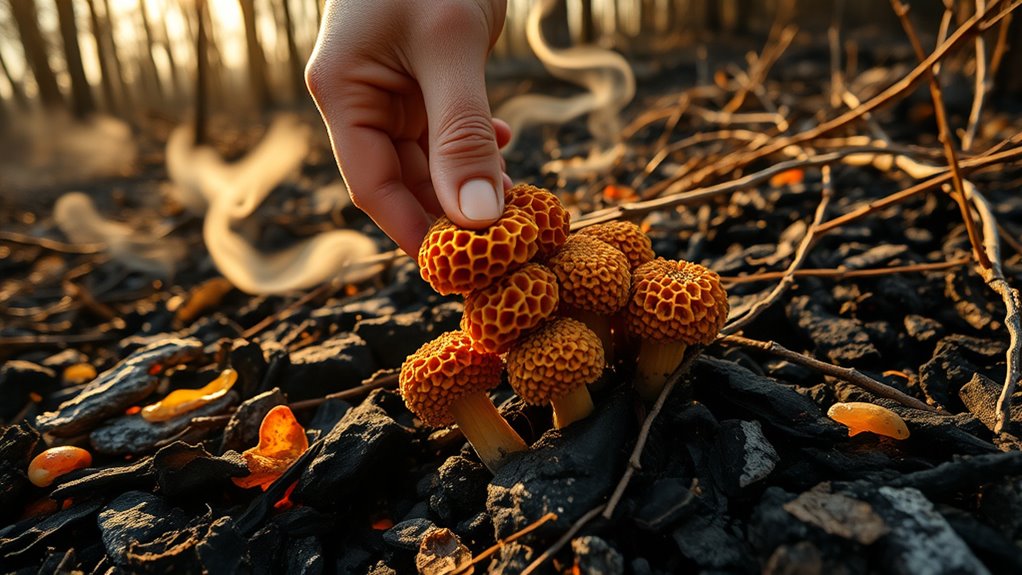
Before you start foraging, it’s important to understand the legal rules in your area, including necessary permits and regulations. You should also practice responsible harvesting by respecting the environment and other foragers. Following these guidelines guarantees you gather morels ethically and sustainably after wildfires. Additionally, being aware of essential oils for environmental health can help you identify and avoid contaminated or unsafe areas during foraging.
Permits and Regulations
After a wildfire, it’s crucial to understand and follow local permits and regulations before foraging for morels. Ignoring these rules can lead to fines or damage to fire safety efforts. To stay compliant, consider these steps:
- Visit your local land management agency’s website to review permit requirements.
- Complete a permit application if needed, ensuring you specify foraging activities.
- Respect fire safety zones; avoid areas marked as unsafe or still under recovery.
- Keep copies of permits visible while foraging, and adhere to any seasonal restrictions.
- Be aware of mechanic shops for fuel injection cleaning, as proper vehicle maintenance may be necessary if traveling to foraging sites.
Following these regulations helps protect the environment and ensures sustainable harvesting. Always prioritize fire safety and stay informed about any updates or changes in rules after wildfire events.
Responsible Harvesting Practices
Responsible harvesting after wildfire events requires you to follow both legal guidelines and ethical principles to protect the recovering ecosystem. Wildfire impact can temporarily weaken soil recovery, making it more vulnerable to disturbance. To minimize harm, only take what you need and avoid overharvesting, which can hinder mycelium growth and soil stability. Stick to designated areas if regulations specify, and respect signs or barriers that indicate sensitive zones. Always dig gently to avoid damaging underlying soil and roots, allowing the environment to continue healing. Remember, your goal is to enjoy the bounty while supporting ecosystem resilience. By practicing responsible foraging, you help ensure morels and other fungi can thrive in the future, even as the landscape recovers from wildfire impact. Additionally, being aware of spoilage signs can help you avoid consuming damaged or unsafe fungi, promoting both health and sustainability.
Recognizing and Avoiding Look-Alike Mushrooms
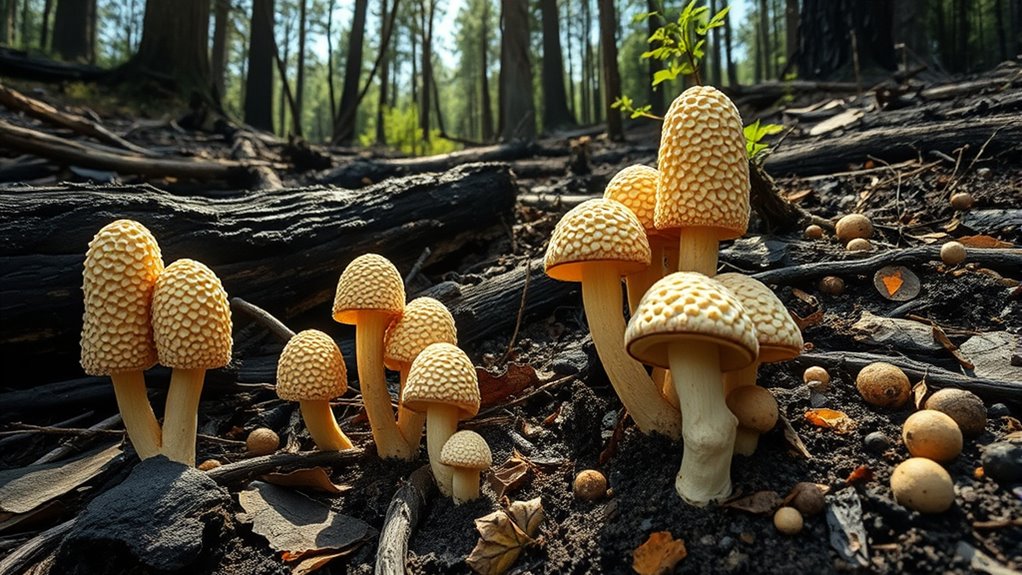
Identifying true morels can be tricky because several look-alike mushrooms can easily be mistaken for them. To avoid dangerous mushroom toxins, you must learn the key differences. Picture these common look-alikes:
- A bulbous, pitted cap that’s smooth and lacks the honeycomb pattern.
- A stem that’s hollow from base to top, with no ridges or bumps.
- A cap that’s attached directly to the stem without a distinct collar.
- Mushrooms with a fibrous, solid interior, unlike true morels’ hollow body.
- Recognizing angel number symbolism can sometimes aid in understanding the significance of subtle signs during your foraging journey.
Always use sharp foraging gear to examine these features closely. Remember, mistaking a false morel for a true one can be deadly. When in doubt, consult a field guide or expert before consuming any mushroom.
Sustainable Harvesting Practices in Burned Ecosystems
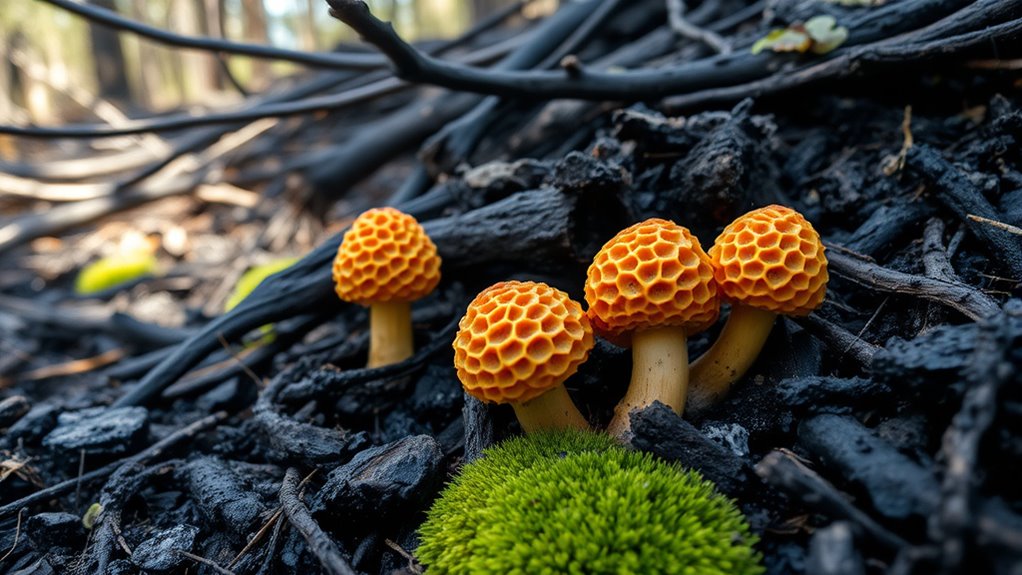
Burned ecosystems offer a unique opportunity for foragers to harvest morels sustainably, but it’s essential to balance gathering with ecological health. To protect soil regeneration, avoid overharvesting and leave some fungi behind to support fungal ecology’s natural balance. Respect the mycelium network by only taking mature morels, which helps ensure continued growth and nutrient cycling. Use gentle techniques, like hand-picking rather than digging, to minimize soil disturbance and preserve underground mycelia. Stay mindful of the ecosystem’s resilience—don’t deplete the local population, especially after a fire where fungal communities are still recovering. By practicing sustainable harvesting, you contribute to the long-term health of the burned landscape, allowing morels and other fungi to thrive and support soil regeneration for future seasons.
Safety Tips for Foraging in Post-Fire Landscapes

Foraging in post-fire landscapes can be rewarding, but it also comes with unique safety considerations. Understanding fire ecology helps you recognize hazards like unstable ground or lingering hot spots. Always prioritize your safety by following these tips:
- Scan the terrain for dead trees or unstable soil that may collapse or cause injury.
- Wear sturdy boots and gloves to protect against sharp debris and rough terrain.
- Learn mushroom identification thoroughly to avoid toxic look-alikes—fire-altered ecosystems can change mushroom appearances.
- Stay alert for signs of residual fire activity, such as smoke or heat, which can pose dangers.
Preparing and Preserving Your Wild Mushroom Harvest
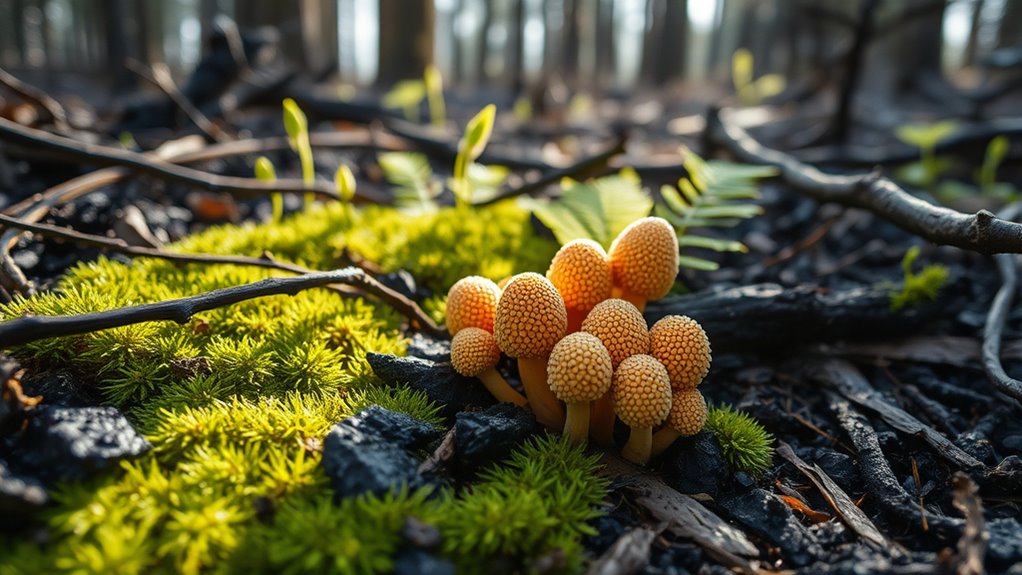
Once you’ve gathered your wild morels, proper preparation and preservation are essential to enjoy them safely and extend their shelf life. Start by cleaning them gently with a brush or damp cloth to remove dirt. To preserve, consider drying them using a dehydrator or air drying in a well-ventilated space—this enhances mushroom cultivation for future harvests. Alternatively, you can freeze cleaned, sliced morels in airtight containers. When cooking, try different techniques like sautéing with butter or incorporating them into soups and stews. Proper storage ensures freshness and safety. Here’s a quick guide:
| Step | Tips |
|---|---|
| Cleaning | Use a soft brush or damp cloth |
| Drying | Dehydrate or air dry in a well-ventilated space |
| Freezing | Store in airtight containers after slicing |
| Cooking techniques | Sauté, stew, or add to pasta |
| Mushroom cultivation | Save spores for future growth and experimentation |
Long-Term Ecological Benefits of Morel Foraging After Fires
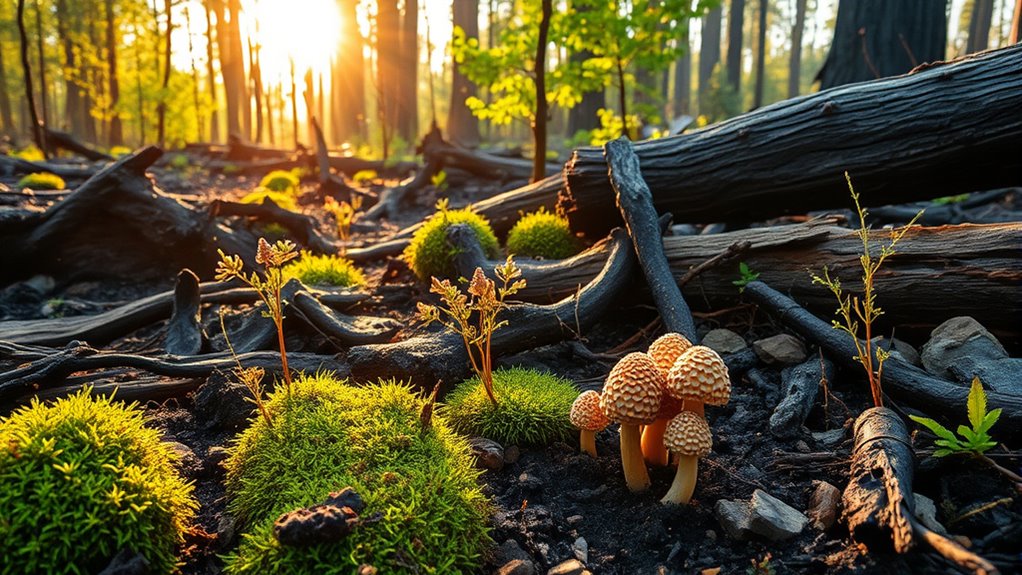
After a wildfire, the ecosystem often experiences a surge in morel populations, which benefits long-term soil health and plant diversity. As you harvest morels, you help facilitate natural processes that improve soil nutrients, supporting ongoing plant succession. This cycle promotes resilient forests and grasslands over time. Visualize:
Harvesting morels after a wildfire boosts soil health and fosters diverse, resilient ecosystems over time.
- Replenished soil teeming with essential nutrients
- New seedlings emerging through the ash-covered ground
- Diverse plant species establishing themselves in burned areas
- Mature forests gradually replacing early successional stages
Frequently Asked Questions
How Do Wildfire Intensity and Duration Affect Morel Abundance?
Wildfire intensity and duration notably influence morel abundance. High fire severity often boosts morel growth, but too intense or prolonged fires can damage soil and mycelium, reducing yields. You should consider fire severity when planning your foraging timing; typically, wait a few weeks after a moderate fire to maximize harvest. Monitoring how long the fire burns helps you identify the best window for morel foraging, ensuring a good harvest.
Are There Specific Plant Indicators That Signal Good Morel Foraging Sites?
While hunting for morels, look for plant succession clues like young, regenerating trees and diverse ground cover, which signal rich fungal activity. These plants often engage in fungal symbiosis, indicating healthy soil conditions perfect for morel growth. Sharp eyes catch these signs—vivid new growth amidst older vegetation—guiding you to prime foraging spots where the synergy between plants and fungi thrives.
Can Foraging for Morels Post-Wildfire Cause Ecosystem Disturbances?
You might wonder if foraging for morels after wildfires causes ecosystem disturbances. While harvesting responsibly, your activities can impact wildlife interactions and soil nutrient cycling. Overharvesting may reduce habitat for animals and disturb the soil’s natural recovery process. To minimize effects, limit your collection, avoid sensitive areas, and respect the environment. This way, you support healthy ecosystems, ensuring future foraging opportunities and ecological balance after wildfire events.
What Are the Best Methods for Distinguishing Morels From Poisonous Look-Alikes?
Imagine spotting a delicate, honeycombed mushroom that could be a prize or a poison. You’ll want sharp mushroom identification skills to tell morels apart from toxic look-alikes. Focus on key features like the distinctive cap texture, color, and the hollow stem. Avoid guesswork—trust your knowledge and compare carefully. If in doubt, consult expert guides or local mycologists to prevent dangerous mistakes. Your safety depends on it.
How Does Soil Composition Change After a Wildfire Influence Morel Growth?
You notice that wildfire changes soil composition by increasing nutrients like ash and minerals, which boost microbial activity. These shifts create a richer environment that encourages morel growth. As the soil becomes more nutrient-dense and microbial activity ramps up, morels find ideal conditions to thrive. So, after a fire, the altered soil composition often results in a prime habitat, making it easier for these fungi to emerge and flourish.
Conclusion
After a wildfire, you have the power to unearth nature’s hidden treasure trove of morels, transforming burned landscapes into vibrant mushroom kingdoms. With the right timing, tools, and respect for the environment, you’ll become a legendary forager, reaping a bounty that could feed a village or fuel an epic adventure. Embrace the chaos of the flames—because in their wake, you’ll find a mushroom paradise waiting to be discovered!

